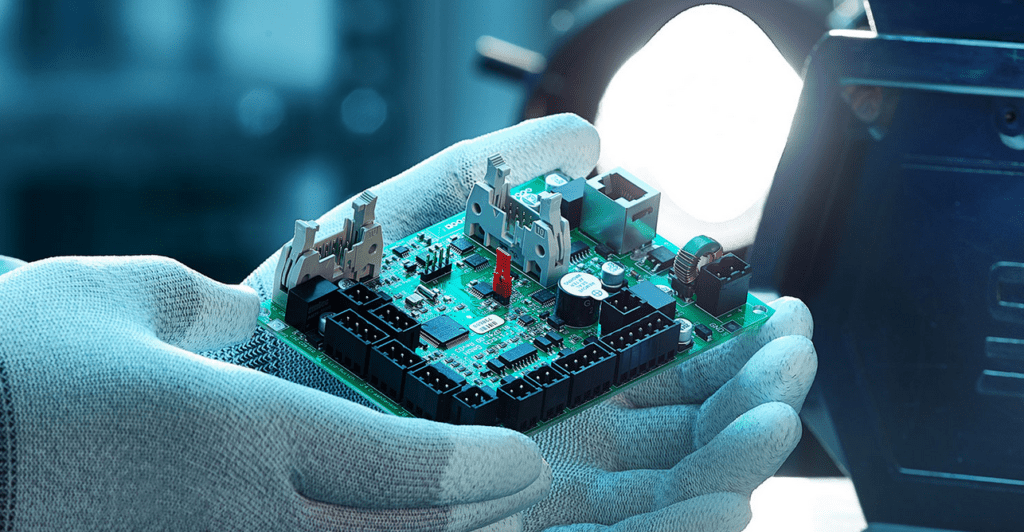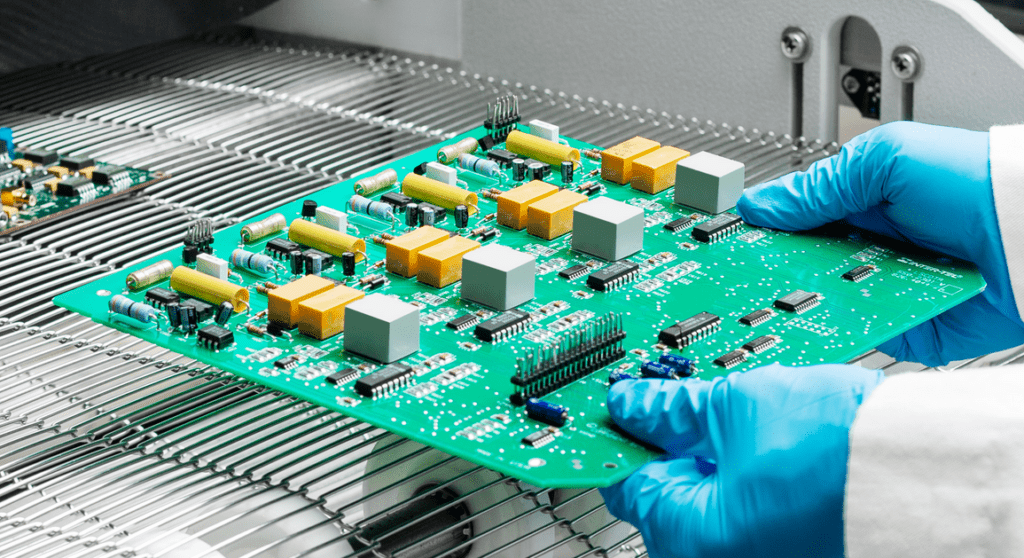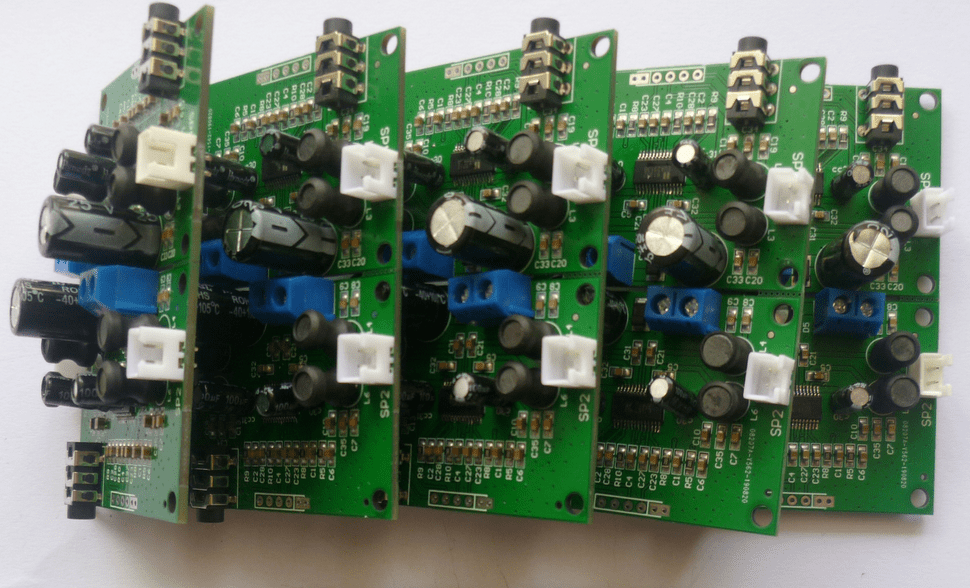What is PCBA Production?
A printed circuit board is a circuit board that has not yet had electronic components soldered on it. PCBA, PCA, or PCB assembly refers to the board after electronic parts are soldered to it. Instruments for assembling printed circuit boards (PCBs) can be either manually or automatically assembled.
Please note that the PCB Production Process is distinct from circuit board assembly. The production of PCBs entails a number of steps, such as PCB design and PCB prototype creation. The final step in preparing a printed board for use in any electronic device is soldering. It involves soldering various passive and active electronic components onto it. The function, type, and purpose of the electronic components make up this assembly.
Many stages get involved during PCBA production. And they must all be carried out correctly to guarantee the final product’s high quality. We hope you find this tour inspiring as we take you through every phase of the manufacturing process.

Steps involved in PCB assembly process
1. Soldering Paste
The first step is to apply solder paste to the circuit board. You can apply solder in the locations where there are electronic parts. Tin accounts for roughly 96.5 percent of the solder paste. It is the most abundant metal in the paste, with other metals like copper and silver rounding out the mix. Solder paste requires flux to melt and adhere to the board.
PCBA makers employ mechanized equipment to hold the solder stencil and circuit boards. It is necessary during the application of solder paste. The correct quantity of solder paste can then be applied with the applicator. After that, the stencil gets removed to reveal the solder paste in its proper location.
2. Pick and Place Procedure
After the correct application of solder paste, a pick-and-place procedure is necessary. Remove the Surface mount components from a reel and place them precisely on the circuit board. Solder paste is sticky enough to keep these parts in place. It is possible to do this operation by hand. Still, most modern factories opt to do it automatically. Because the entire procedure occurs by a machine, it enhances accuracy and productivity. Also, automatic selection and place guarantee PCBA reliability in every run.
3. Reflow Soldering process
PCBA makers use reflow solder to connect SMD components to the board. It is possible after installing them on the board. How does it function, then? It will move to a belt conveyor that would go through a massive hot oven. The oven’s several heaters bring the temperature up to roughly 250 degrees Celsius.
It melts the solder on the circuit boards and transforms them into solder paste printing. The board would next move through a succession of coolers. This action would cool the molten solder paste and harden it into a solder bond. This allows for the secure assembly of surface-mounted components.
4. Examining the Results in PCBA manufacturing process
Reflow solder can leave circuit boards vulnerable to issues. The common issues include poor connection integrity and short circuits. This stage is where producers apply a variety of ways to check the PCBA and test the board’s performance.
Two PRINTED CIRCUIT BOARD ASSEMBLY testing procedures are:
· Automatic Optical Inspection:
An automatic optical examination can discover errors and defects in the circuit with great accuracy and rapid speed. It is preferable to manual soldering when inspecting large volumes of PCBA orders. There is a significant function for a high-powered camera-equipped automated machine. It can examine the connection from a variety of angles in the optical testing phase. Furthermore, the equipment can examine the strength of solder joints. It becomes possible by measuring the reflected light intensity.
· X-ray inspection:
X-ray inspection utilizes x-rays to examine printed circuit boards. It is an excellent option when inspecting PCBAs of a complicated and multilayered design. X-rays allow us to see through the board’s layers. It helps in revealing any flaws, even those hidden in the lowest layer.
The board has two passes of examination before performing a functional test. It ensures full functionality.
5. Plating the Through-Hole components
In addition to surface mount parts, PTH components are common across a wide range of PCBA kinds. PTH assembly involves drilling holes in a printed circuit board. It makes sure that elements can transmit data from one end to the other. In addition, PTH soldering can be done in two distinct ways:
Hand Soldering: All components are on the board by hand at this stage. How it functions is that one person will be in charge of inserting one form of element in the needed location. Then, transfer the boards to another workspace. There another person will insert another kind of component, and so on. The process gets repeated until all the holes get filled with the appropriate component.
Wave soldering is another common method of soldering used for through-hole PCBs. A pumped wave or cascade of solder would be used to transfer the board as the PTH parts are placed on it. The conveyor would then move the board along. Good electrical and mechanical connections are made when the solder is smeared over the board’s exposed metallic surfaces.
6. Functionality Test
The final phase in making PCBs is functional testing or a thorough inspection of all the boards. The PCBA would be put through its paces while the circuit was operating. Testing PCBA’s electrical properties are essential before sending power signals. It also sends the simulated signals via it. If the range of variation for these characteristics exceeds, the board fails the evaluation.
Advantages of Professional PCB Assembly services

1. Cost-effective
Saving on non-essential capital expenses is one of the main advantages of contracting PCB assembly for your company. If your organization can keep costs down and put off the necessity for constant mass production of electrical equipment, then you will see maximum success from this method.
Because of its specific needs, SMT manufacturing calls for dedicated manufacturing space. A sizable preliminary investment is also essential for the acquisition of quality assurance instruments and SMDs.
For highly specialized goods used in fields like aerospace and medicine. It also includes the cost of obtaining authorization to produce circuit boards. Ongoing spending on electronic circuit assembling service – human costs: yearly salary, certification and training fees, supplementary social bundles, e.g., retirement or health insurance, are just as serious issues as the upfront costs of infrastructure (acquisition, customization to the company’s manufacturing profile, upkeep, and maintenance).
Offshoring manufacturing has several positive effects on the electronics business. OEMs in the semiconductor industry can take advantage of scale economies. It is possible by contracting PCB manufacturing to a reliable EMS.
You can reduce the price of your product per unit and remain competitive. This becomes possible by investing in other parts of your company. And spending less on the production of electrical components.
2. Efficiency in Operation
Rather than having to set up a shop from zero. A PCB assembly firm already has a well-established infrastructure for manufacturing PCB boards. Also, it has the business knowledge to fall back on, so it may use tried and tested production techniques.
An expert EMS can manage inventory. Besides this, he can also manage other factors that affect cost-effectiveness in the face of the short lifespan of components, price and supply fluctuations, and design changes.
Outsourcing PCB production to a seasoned PCB assembly provider of very well Surface Mount Technology SMT assembly solutions is a viable choice for young businesses short on capital, such as those that cannot manage to have their investment trapped in their stock for many months.
3. Expertise at your disposal

Selecting a professional EMS is essential because of their manufacturing knowledge and experience. A contract electronics supplier is a qualified expert in SMT assembly because it is the only thing it does.
An experienced EMS may quickly and efficiently assess the user manuals. After that, he may make significant design revisions before production even begins. Perhaps, by reducing the amount of time required to manufacture a series of products or identifying design defects and non-conformances in components.
Qualifications in areas like business continuity planning (showing that a contractor is ready for emergencies) and medical project specialization (showing that a contractor understands the unique challenges such projects provide) are among the several EMS credentials that carry equal weight.
4. Service Following Purchase
If you and your PCB board assembling manufacturer have a good working relationship. They may become more like partners in your company than subcontractors. The two parties working together could reap several benefits associated with outsourcing manufacturing.
Advice on design for ease of manufacture and help with manufacturing prototypes are only some of the many services given by a competent EMS group. You’ll be better able to focus on product innovation and hence keep up with rivals if you do this.
Any problems that may develop after the release of your product can be handled by an EMS. It offers a wide range of services. Reports of faults submitted by consumers may be analyzed to learn how quickly and where objects are damaged in actual consumption.
Due to widespread interaction, this vital information is for the OEM’s doorstep or inbox.
5. Comprehensive Methodology
It’s not uncommon for PCBs to be missing key components when sold. When developing new goods with substantial “box build” options, design engineers must manage the operations of multiple PCB assembly providers to complete the final product.
The tremendous segmentation of components made by diverse suppliers, which often leads to parts that don’t match together, requires a massive organizational effort to deal with. Any breakdown in communication might result in wasted time and money.
The use of an outsourced production plant, such as an EMS, may help you save cost and time by handling every step of the production process, from assembly to packaging. When all components of the system are in the same place, and with the same vendor, the final assembly can go along more quickly.
Production will continue as usual irrespective of the volume goal.
Many EMS contract manufacturers offer the benefits of outsourcing manufacturing regardless of the order.
They are unconcerned with the quantity of PCBs or printed circuit assemblies that you need. Both ways, they can help you out. To assemble PCBs in big batches at much cheaper costs, it is necessary to invest in the control unit and SMD expenditures and to hire competent people.
6. PCBs assembling for orders of any size

A competent EMS will usually be able to assist with PCB assembly runs of tens to hundreds, as well as production runs of one to one thousand units. This comprises the production of PCB assembly sets with a low volume and a high mix, typically between a few thousand and a few tens of millions of components.
7. Better Supply Chain Management
Gaining expertise in flexible supply chains is challenging. Dealing with an EMS that has access to vast supply chains makes it easy to handle problems like a regular shortage of commercial parts or the depreciation of components. A contract electronics retailer may also be responsible for additional tasks that have a direct bearing on logistics and technology, such as maintenance and warranty.
8. Early Detection of Errors
Even experts with years of experience designing printed circuit boards sometimes make mistakes. If you committed the same mistake on every one of your circuit boards, you might stand to lose a significant amount of money.
An expert in PCB assembly is to prevent this from occurring. PCBA Circuits performs expert reviews of designs, regardless of whether or not they have been tested, to eliminate the possibility of surprises down the road.
This gives you assurance to move through with the meeting. After the circuit boards are put in place, their proper operation is essential.
If you need help with circuit design, you can use the free software we provide. A benefit of adopting it is that it simplifies things and reduces the possibility of making mistakes. As soon as we have the boards, we’ll check them over to make sure they’re well-designed. Getting on top of a mistake as soon as possible is beneficial for all parties. Basically, you’ll have time to fix any problems before starting full production.
9. Package Delivery Covered
The manufacturer offers immediate home or workplace delivery after complete PCB assembly. The reliable manufacturer offers the fastest shipping time for product delivery. This will ensure that your circuit boards get to you quickly.


